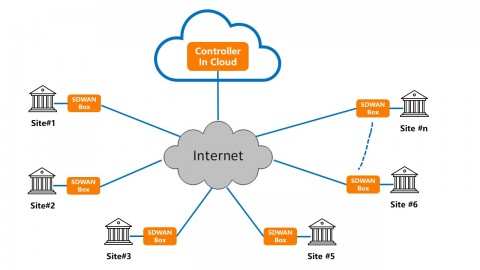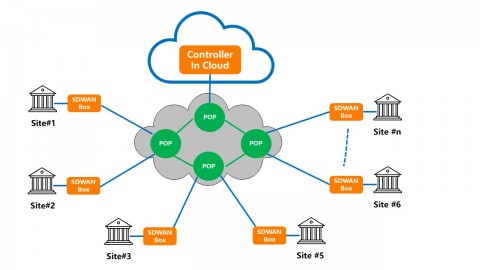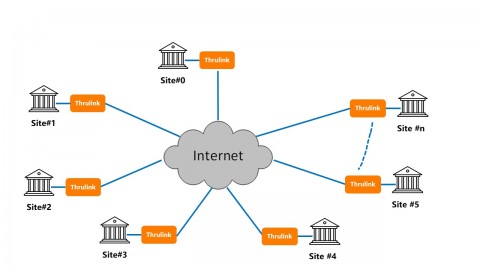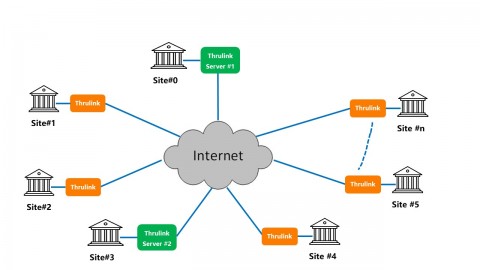Since entering the public domain in 2014, the software-defined wide area network (SD-WAN) has earned widespread favor for reducing costs related to the more conventional multiprotocol label switching (MPLS) and other broadband connections.
SD-WAN centralizes control in the Cloud, helping installing security contractors provide increased flexibility and edge-based operation to their video systems clientele. Yet despite numerous networking advantages, such as WAN simplification and increased application performance, ahead, we're going to explain how to achieve even greater rewards utilizing SD-WAN.
SD-WAN Total Cost of Ownership
Generally, IT departments will deploy either of two variations of SD-WAN system layouts. As illustrated in the diagram below, SD-WAN boxes allow organizations to easily connect between the head office and branch locations, regardless of network environment and connection type. The performance of this layout relies entirely on the quality of the Internet, and the cost for both the SD-WAN provider and users are significantly reduced.
A second SD-WAN layout is similar to the one above, but the SD-WAN provider offers better performance by adding their own point-of-presence (POP) nodes in the key areas. In this network model (see below), the SD-WAN provider's investment is higher by comparison to the first layout, which increases costs to the end user.
A popular alternative to augment or replace MPLS as part of a network upgrade is SD-WAN as a Service. Users purchase SD-WAN boxes at a reasonable price, but pay an annual license fee. Although the initial investment is low, over time the license fees can really begin to add up. There's another significant drawback in the above SD-WAN system configuration: Users cannot operate the Cloud-based controller. Instead, the user's equipment and data are entirely under the SD-WAN provider's control. The provider can access the user's network data, which presents a potential cybersecurity risk.
The ThruLink™ Advantage
You might be wondering if there is one solution that offers the same SD-WAN advantages but remains entirely under the user's control? Yes! Our ThruLink product is a fully encrypted VPN solution, license-free, 100% agnostic and optimized for use with video surveillance systems.
ThruLink serves as an end-to-end hardware encrypted gateway designed to offer secure data transmission over any public network. Its role is similar to the SD-WAN box, but the big difference is that all ThruLink devices can be installed on the user's personal network and facility. This means everything is under the user's control!
Here is a typical ThruLink system layout:
From a cybersecurity perspective, ThruLink is far more secure than a SD-WAN deployment. Whereas SD-WAN only implements the IPSec or SSL protocols, the ThruLink design is quite different. ThruLink uses two-way asynchronous authentication, making it impervious to all man-in-the-middle (MITM) attacks.
In many applications, viewing live video remotely via the Internet is required. Because of unstable end-to-end available bandwidth via the Internet, achieving high video quality can present a real challenge. ThruLink is optimized for live video transmission by leveraging maximum transmission unit (MTU) technology. ThruLink also supports multicast on the public Internet, which is unavailable in most SD-WAN solutions.
As for flexibility, ThruLink is much more accommodating than SD-WAN. In a ThruLink network, any unit can be set up as a server (controller) on any premise, and more than one server can be set up for failover protection:
To recap, when considering cost, keep in mind that ThruLink is built on the public Internet with no license fees. Unlike SD-WAN, the end customer pays just a one-time hardware investment. ThruLink provides most of SD-WAN's advantages but offers more flexibility, more security and a lower cost for the customer. If you are interested in testing this application for your networking needs, please get in touch with KBC Networks at This email address is being protected from spambots. You need JavaScript enabled to view it..



